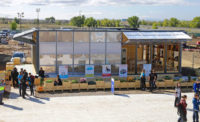Bill Gates can be prescient. He famously predicted aspects of the current pandemic in a 2015 TED talk. And in his new book, published just before the recent power outages in Texas, he explains that in the United States, "There isn’t one power grid; there are many, and they’re a patchwork mess that makes it essentially impossible to send electricity beyond the region where it’s made.” For that reason, he mentions, almost casually, he is funding a computer model of all the power grids in the country.
His book, How to Avoid a Climate Disaster, is easy to understand—Gates is a gifted explainer—but not easy to summarize, because there isn’t one “silver bullet” for the climate crisis. He thinks we need to do many different things at once and, being Bill Gates, he knows a lot about a lot of them, from why we need to plant more mangroves (“cheaper than building breakwaters”) to just how much money you can save by replacing your air conditioner with a heat pump if you live in Providence, Rhode Island ($2,755 over 15 years). And fixing that patchwork power grid is essential because, as he points out, we'll need to transmit power from places where wind turbines or solar panels operate efficiently to places where they don't.
A big part of Gates’s climate plan is to electrify everything that can be electrified, a goal many climate activists share. New and existing homes would have to have electric furnaces, electric water heaters, and electric stoves, as well as charging stations for electric cars. We need to upgrade the electrical service to our houses at least by a factor of two, he says, which will mean digging up streets and cutting down trees to hang new cables and transformers. That could lead to political pushback, he cautions, in a book that is as much about practicality as it is about technology.
For example, power lines are an eyesore, but burying cables costs five to ten times as much as stringing them from poles, in part because the cables generate heat. But some companies, he assures us, are working to “eliminate the heat problem and reduce the cost of underground lines significantly.” You get the feeling that if you called Gates, he would tell you how many new circuit breakers you’ll need, and he might even come over and install them for you.
Gates is keenly aware of the role buildings play in greenhouse gas emissions. Early on, he lays out five key questions that must be asked about any proposal to mitigate climate change. Somewhat surprisingly, question two is, “What’s your plan for cement?” Making steel and cement accounts for ten percent of emissions worldwide, and while significant progress is being made on steel, cement is resistant to change. (It requires calcium, which is harvested from limestone, freeing the stone’s carbon and oxygen as, alas, carbon dioxide.) He mentions an effort to inject carbon dioxide back into concrete before it hardens, and an idea for getting the needed calcium from seawater, but concludes that the only practical solution right now is installing carbon capture equipment at cement plants, possibly doubling its price.
As for making buildings more efficient, Gates says we know how to do it, and he points to the success of Seattle’s Bullitt Center, by Miller Hull Architects. But he concedes that Bullitt was prohibitively expensive, noting wryly that its cost explains why, seven years after it was built, it remains one of the greenest buildings in the world.
Gates admits that, as a rich man with an “absurdly high” carbon footprint, he is an “imperfect messenger on climate change.” But for a billionaire, Gates is surprisingly attuned to the cost of things, especially for the world’s least fortunate. His plan is steeped in humanity: he rejects as cruel the idea that residents of developing countries need to cut their power consumption to help meet climate targets. No, he insists, they need to increase their power consumption, so they can enjoy a decent standard of living. That’s only fair! We’re just going to have to generate all that NEW power cleanly.





Post a comment to this article
Report Abusive Comment